Biermann Ch. Handbook of Pulping and Papermaking
Подождите немного. Документ загружается.

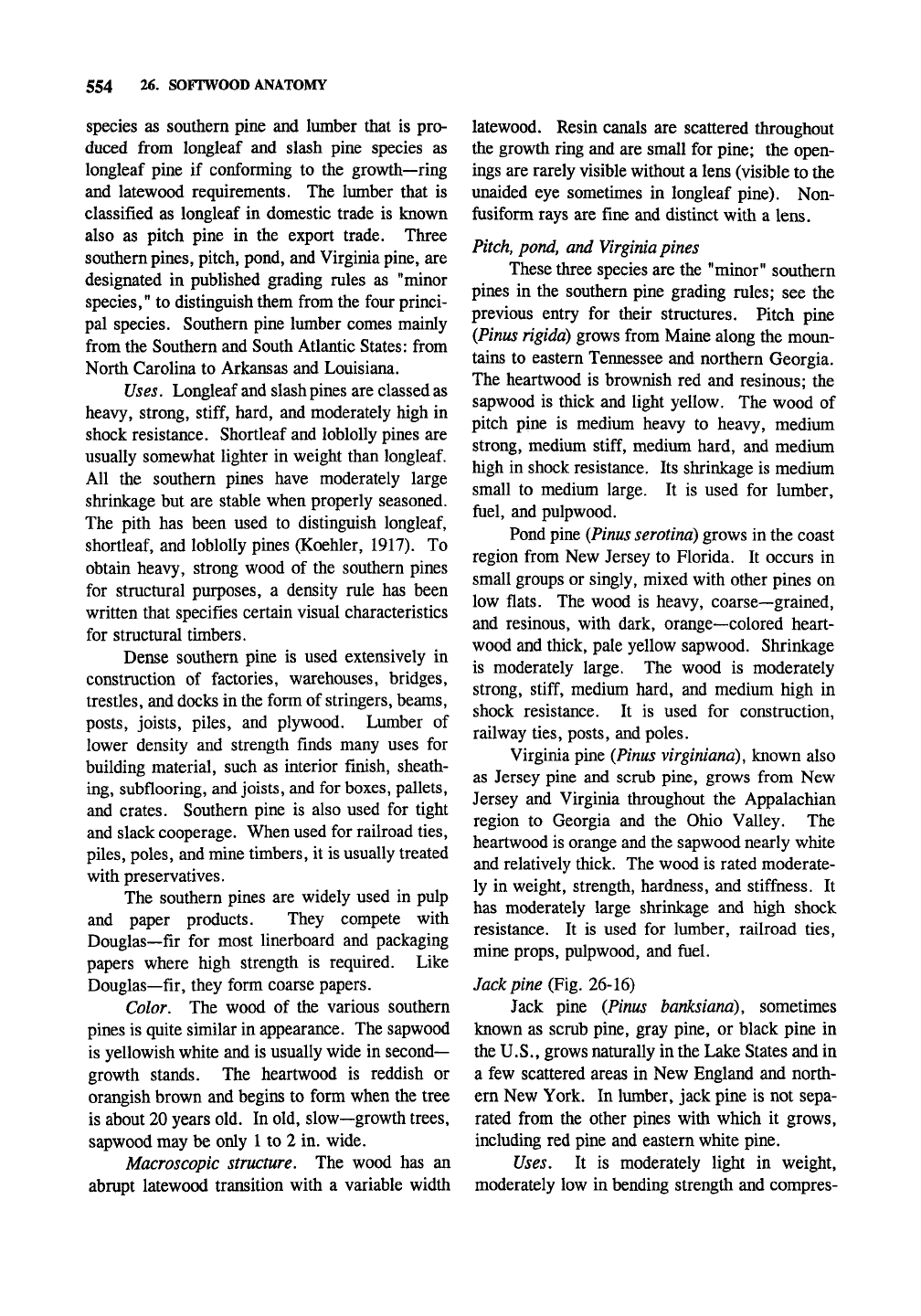
554 26. SOFTWOOD ANATOMY
species as southern pine and lumber that is pro-
duced from longleaf and slash pine species as
longleaf pine if conforming to the growth—ring
and latewood requirements. The lumber that is
classified as longleaf in domestic trade is known
also as pitch pine in the export trade. Three
southern
pines,
pitch, pond, and Virginia pine, are
designated in published grading rules as "minor
species," to distinguish them from the four princi-
pal species. Southern pine lumber comes mainly
from the Southern and South Atlantic States: from
North Carolina to Arkansas and Louisiana.
Uses. Longleaf and slash pines are classed as
heavy, strong,
stiff,
hard, and moderately high in
shock resistance. Shortleaf and loblolly pines are
usually somewhat lighter in weight than
longleaf.
All the southern pines have moderately large
shrinkage but are stable when properly seasoned.
The pith has been used to distinguish
longleaf,
shortleaf,
and loblolly pines (Koehler, 1917). To
obtain heavy, strong wood of the southern pines
for structural purposes, a density rule has been
written that specifies certain visual characteristics
for structural timbers.
Dense southern pine is used extensively in
construction of factories, warehouses, bridges,
trestles, and docks in the form of stringers, beams,
posts,
joists, piles, and plywood. Lumber of
lower density and strength finds many uses for
building material, such as interior finish, sheath-
ing, subflooring, and joists, and for boxes, pallets,
and crates. Southern pine is also used for tight
and slack cooperage. When used for railroad ties,
piles,
poles, and mine timbers, it is usually treated
with preservatives.
The southern pines are widely used in pulp
and paper products. They compete with
Douglas—fir for most linerboard and packaging
papers where high strength is required. Like
Douglas—fir, they form coarse papers.
Color. The wood of the various southern
pines is quite similar in appearance. The sapwood
is yellowish white and is usually wide in second-
growth stands. The heartwood is reddish or
orangish brown and begins to form when the tree
is about 20 years old. In old, slow—growth trees,
sapwood may be only 1 to 2 in. wide.
Macroscopic structure. The wood has an
abrupt latewood transition with a variable width
latewood. Resin canals are scattered throughout
the growth ring and are small for pine; the open-
ings are rarely visible without a lens (visible to the
unaided eye sometimes in longleaf pine). Non-
fusiform rays are fine and distinct with a lens.
Pitch,
pond,
and
Virginia
pines
These three species are the "minor" southern
pines in the southern pine grading rules; see the
previous entry for their structures. Pitch pine
(Pinus rigida) grows from Maine along the moun-
tains to eastern Tennessee and northern Georgia.
The heartwood is brownish red and resinous; the
sapwood is thick and light yellow. The wood of
pitch pine is medium heavy to heavy, medium
strong, medium
stiff,
medium hard, and medium
high in shock resistance. Its shrinkage is medium
small to medium large. It is used for lumber,
fuel, and pulpwood.
Pond pine
{Pinus serotina)
grows in the coast
region from New Jersey to Florida. It occurs in
small groups or singly, mixed with other pines on
low flats. The wood is heavy, coarse—grained,
and resinous, with dark, orange—colored heart-
wood and thick, pale yellow sapwood. Shrinkage
is moderately large. The wood is moderately
strong,
stiff,
medium hard, and medium high in
shock resistance. It is used for construction,
railway ties, posts, and poles.
Virginia pine (Pinus virginiana), known also
as Jersey pine and scrub pine, grows from New
Jersey and Virginia throughout the Appalachian
region to Georgia and the Ohio Valley. The
heartwood is orange and the sapwood nearly white
and relatively thick. The wood is rated moderate-
ly in weight, strength, hardness, and stiffiiess. It
has moderately large shrinkage and high shock
resistance. It is used for lumber, railroad ties,
mine props, pulpwood, and fuel.
Jack pine (Fig. 26-16)
Jack pine (Pinus banksiana), sometimes
known as scrub pine, gray pine, or black pine in
the U.S., grows naturally in the Lake States and in
a few scattered areas in New England and north-
ern New York. In lumber, jack pine is not sepa-
rated from the other pines with which it grows,
including red pine and eastern white pine.
Uses. It is moderately light in weight,
moderately low in bending strength and compres-
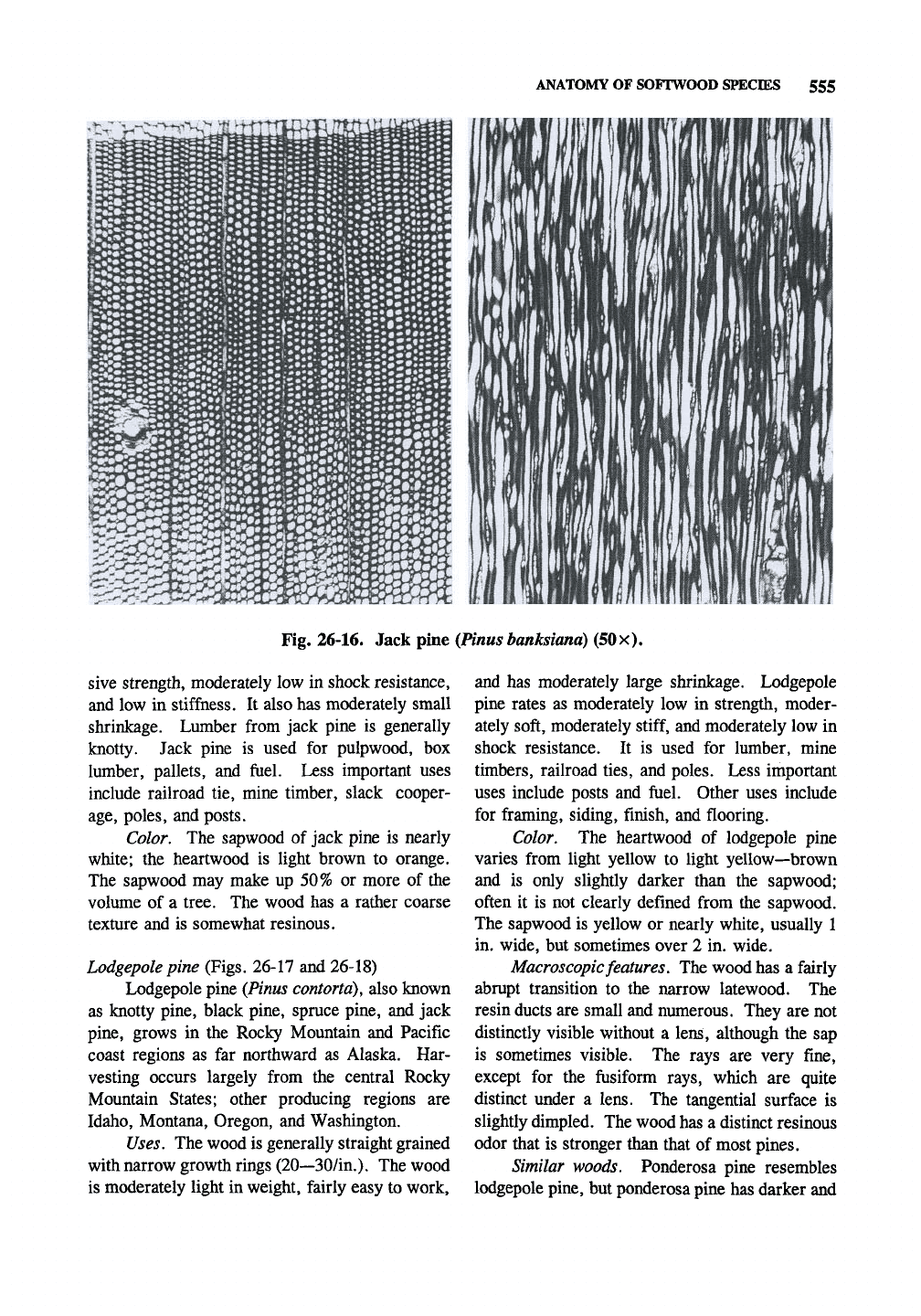
ANATOMY OF SOFTWOOD SPECIES 555
Fig. 26-16. Jack pine
(Pinus banksiana) (50
x).
sive strength, moderately low in shock resistance,
and low in stiffness. It also has moderately small
shrinkage. Lumber from jack pine is generally
knotty. Jack pine is used for pulpwood, box
lumber, pallets, and fuel. Less important uses
include railroad tie, mine timber, slack cooper-
age,
poles, and posts.
Color. The sapwood of jack pine is nearly
white; the heartwood is light brown to orange.
The sapwood may make up 50% or more of the
volume of a tree. The wood has a rather coarse
texture and is somewhat resinous.
Lodgepole pine (Figs. 26-17 and 26-18)
Lodgepole pine (Pinus contorta), also known
as knotty pine, black pine, spruce pine, and jack
pine,
grows in the Rocky Mountain and Pacific
coast regions as far northward as Alaska. Har-
vesting occurs largely from the central Rocky
Mountain States; other producing regions are
Idaho, Montana, Oregon, and Washington.
Uses. The wood is generally straight grained
with narrow growth rings (20—30/in.). The wood
is moderately light in weight, fairly easy to work.
and has moderately large shrinkage. Lodgepole
pine rates as moderately low in strength, moder-
ately soft, moderately
stiff,
and moderately low in
shock resistance. It is used for lumber, mine
timbers, railroad ties, and poles. Less important
uses include posts and fuel. Other uses include
for framing, siding, finish, and flooring.
Color. The heartwood of lodgepole pine
varies from light yellow to light yellow—brown
and is only slightly darker than the sapwood;
often it is not clearly defined from the sapwood.
The sapwood is yellow or nearly white, usually 1
in. wide, but sometimes over 2 in. wide.
Macroscopic features. The wood has a fairly
abrupt transition to the narrow latewood. The
resin ducts are small and numerous. They are not
distinctly visible without a lens, although the sap
is sometimes visible. The rays are very fine,
except for the fusiform rays, which are quite
distinct under a lens. The tangential surface is
slightly dimpled. The wood has a distinct resinous
odor that is stronger than that of most pines.
Similar woods. Ponderosa pine resembles
lodgepole pine, but ponderosa pine has darker and
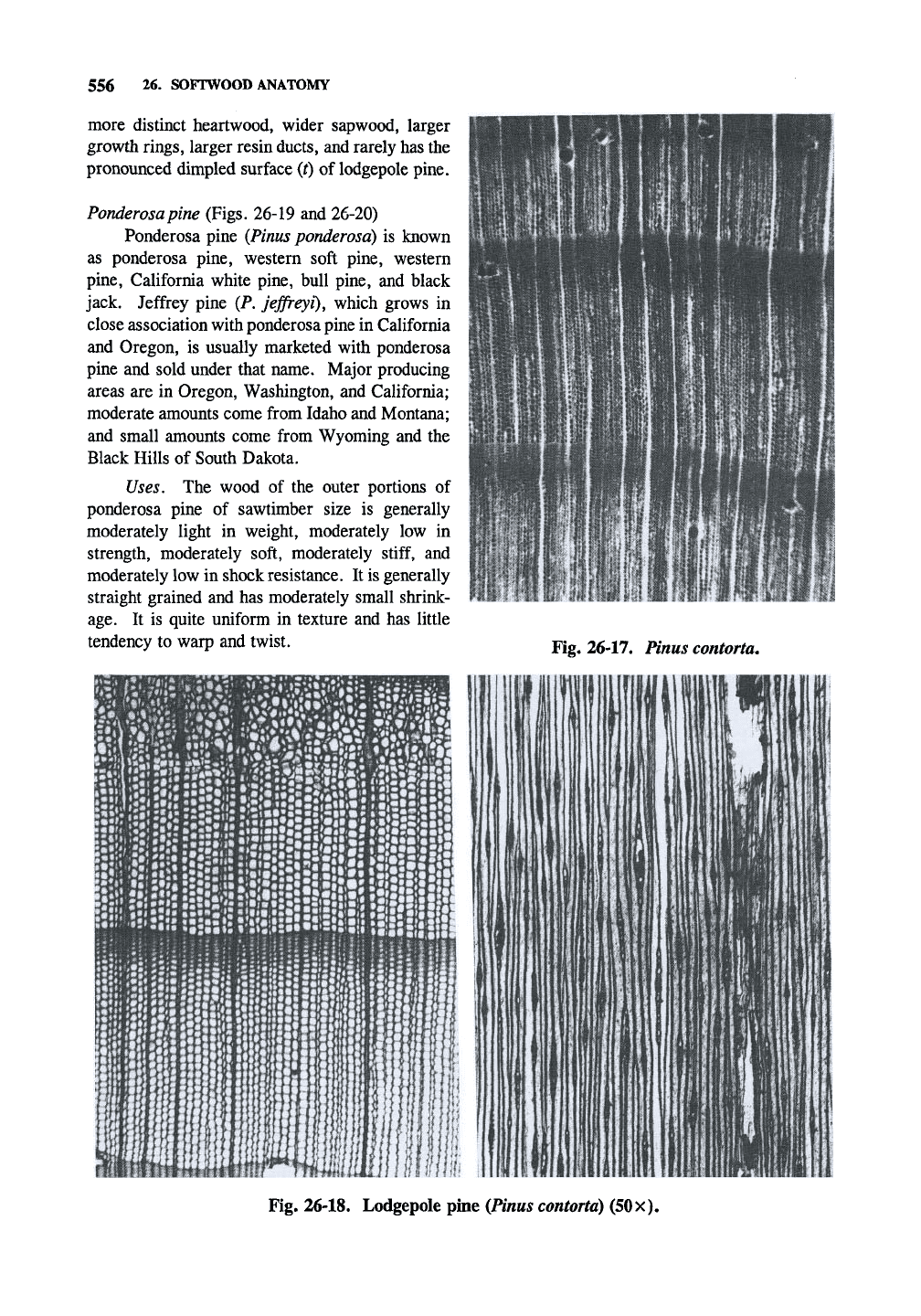
556 26. SOFTWOOD ANATOMY
more distinct heartwood, wider sapwood, larger
growth rings, larger resin
ducts,
and rarely has the
pronounced dimpled surface (t) of lodgepole pine.
Ponderosapine (Figs. 26-19 and 26-20)
Ponderosa pine
{Pinus
ponderosa) is known
as ponderosa pine, western soft pine, western
pine,
California white pine, bull pine, and black
jack. Jeffrey pine (P. jejfreyi), which grows in
close association with ponderosa pine in California
and Oregon, is usually marketed with ponderosa
pine and sold under that name. Major producing
areas are in Oregon, Washington, and California;
moderate amounts come from Idaho and Montana;
and small amounts come from Wyoming and the
Black Hills of South Dakota.
Uses. The wood of the outer portions of
ponderosa pine of sawtimber size is generally
moderately light in weight, moderately low in
strength, moderately soft, moderately
stiff,
and
moderately low in shock resistance, ft is generally
straight grained and has moderately small shrink-
age,
ft is quite uniform in texture and has little
tendency to warp and twist.
Fig. 26-17. Pinus contorta.
Fig. 26-18. Lodgepole pine
{Pinus contorta) (50
x).
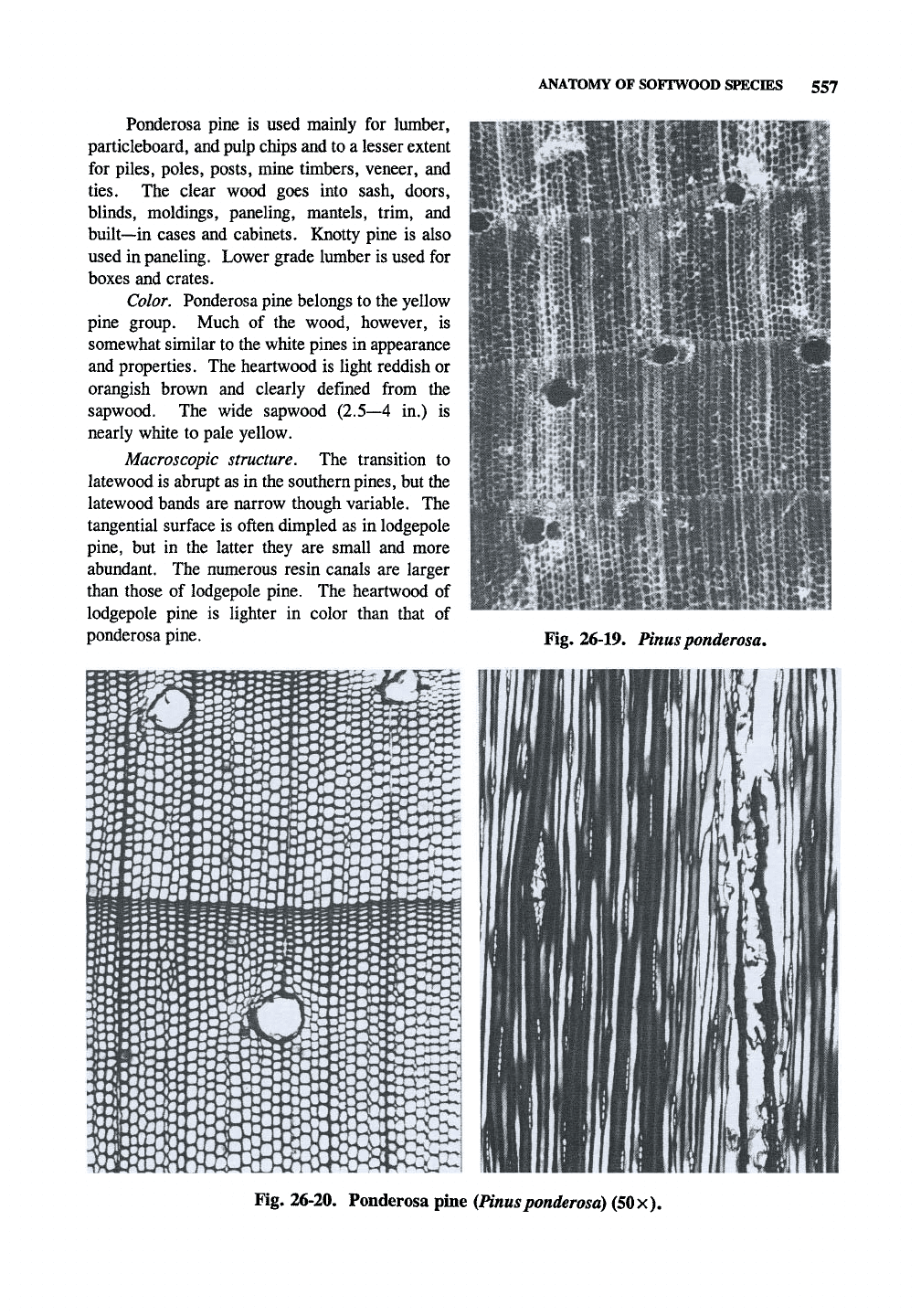
ANATOMY OF SOFTWOOD SPECDSS 557
Ponderosa pine is used mainly for lumber,
particleboard, and pulp chips and to a lesser extent
for piles, poles, posts, mine timbers, veneer, and
ties.
The clear wood goes into sash, doors,
blinds, moldings, paneling, mantels, trim, and
built—in cases and cabinets. Knotty pine is also
used in paneling. Lower grade lumber is used for
boxes and crates.
Color. Ponderosa pine belongs to the yellow
pine group. Much of the wood, however, is
somewhat similar to the white pines in appearance
and properties. The heartwood is light reddish or
orangish brown and clearly defined from the
sapwood. The wide sapwood (2.5—4 in.) is
nearly white to pale yellow.
Macroscopic structure. The transition to
latewood is abrupt as in the southern
pines,
but the
latewood bands are narrow though variable. The
tangential surface is often dimpled as in lodgepole
pine,
but in the latter they are small and more
abundant. The numerous resin canals are larger
than those of lodgepole pine. The heartwood of
lodgepole pine is lighter in color than that of
ponderosa pine.
Fig. 26-19. Pinus ponderosa.
Fig. 26-20. Ponderosa pine (Pinusponderosa) (50x).
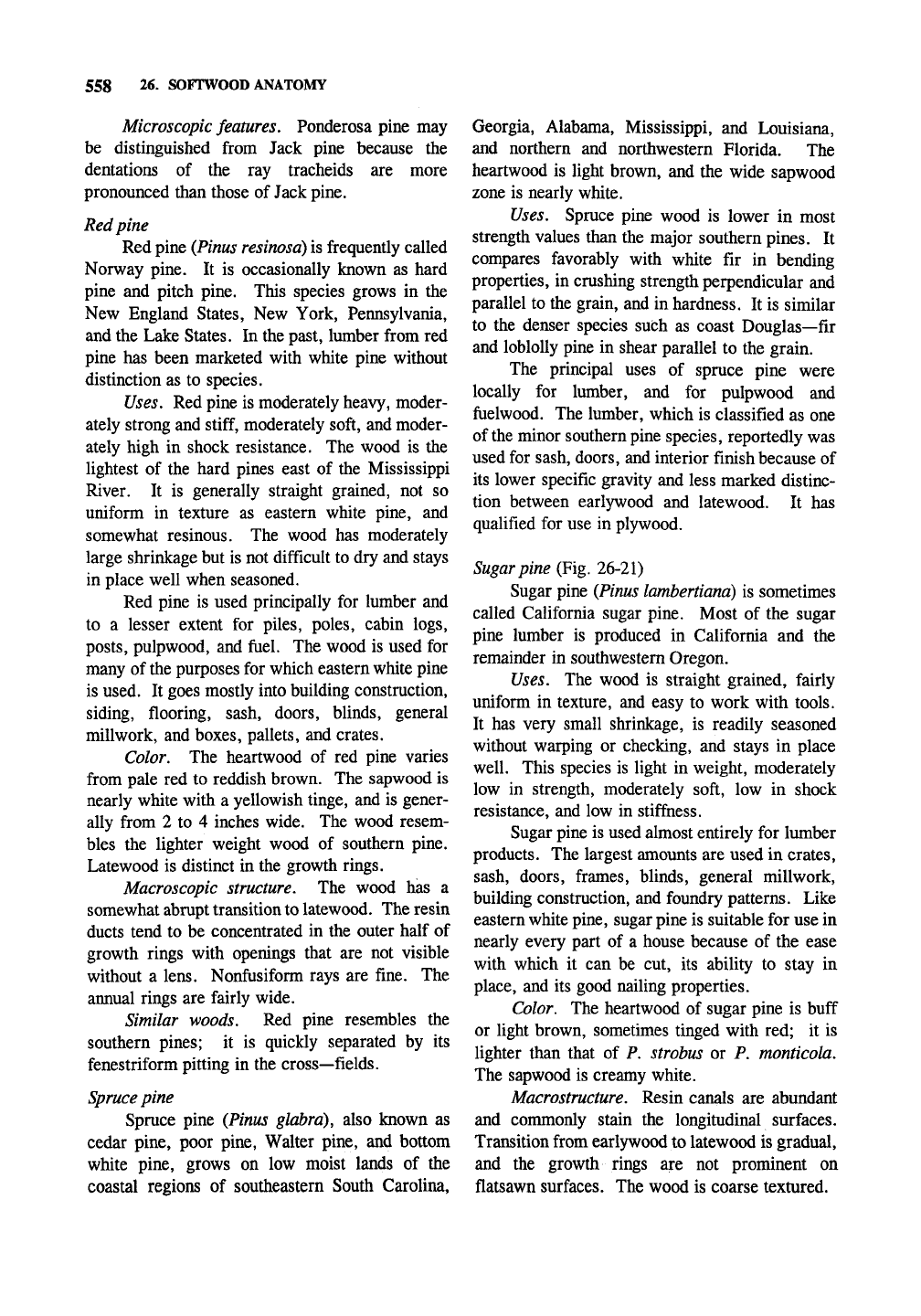
558 26. SOFTWOOD ANATOMY
Microscopic features, Ponderosa pine may
be distinguished from Jack pine because the
dentations of the ray tracheids are more
pronounced than those of Jack pine.
Red pine
Red pine (Pinus
resinosa)
is frequently called
Norway pine. It is occasionally known as hard
pine and pitch pine. This species grows in the
New England States, New York, Pennsylvania,
and the Lake States. In the past, lumber from red
pine has been marketed with white pine without
distinction as to species.
Uses. Red pine is moderately heavy, moder-
ately strong and
stiff,
moderately soft, and moder-
ately high in shock resistance. The wood is the
lightest of the hard pines east of the Mississippi
River. It is generally straight grained, not so
uniform in texture as eastern white pine, and
somewhat resinous. The wood has moderately
large shrinkage but is not difficult to dry and stays
in place well when seasoned.
Red pine is used principally for lumber and
to a lesser extent for piles, poles, cabin logs,
posts,
pulpwood, and fuel. The wood is used for
many of
the
purposes for which eastern white pine
is used. It goes mostly into building construction,
siding, flooring, sash, doors, blinds, general
millwork, and boxes, pallets, and crates.
Color. The heartwood of red pine varies
from pale red to reddish brown. The sapwood is
nearly white with a yellowish tinge, and is gener-
ally from 2 to 4 inches wide. The wood resem-
bles the lighter weight wood of southern pine.
Latewood is distinct in the growth rings.
Macroscopic structure. The wood has a
somewhat abrupt transition
to
latewood. The resin
ducts tend to be concentrated in the outer half of
growth rings with openings that are not visible
without a lens. Nonfusiform rays are fine. The
annual rings are fairly wide.
Similar woods. Red pine resembles the
southern pines; it is quickly separated by its
fenestriform pitting in the cross—fields.
Spruce
pine
Spruce pine (Pinus glabra), also known as
cedar pine, poor pine, Walter pine, and bottom
white pine, grows on low moist lands of the
coastal regions of southeastern South Carolina,
Georgia, Alabama, Mississippi, and Louisiana,
and northern and northwestern Florida. The
heartwood is light brown, and the wide sapwood
zone is nearly white.
Uses. Spruce pine wood is lower in most
strength values than the major southern pines. It
compares favorably with white fir in bending
properties, in crushing strength perpendicular and
parallel to the grain, and in hardness. It is similar
to the denser species such as coast Douglas—fir
and loblolly pine in shear parallel to the grain.
The principal uses of spruce pine were
locally for lumber, and for pulpwood and
fuelwood. The lumber, which is classified as one
of
the
minor southern pine species, reportedly was
used for sash, doors, and interior finish because of
its lower specific gravity and less marked distinc-
tion between earlywood and latewood. It has
qualified for use in plywood.
Sugar pine (Fig. 26-21)
Sugar pine (Pinus lambertiana) is sometimes
called California sugar pine. Most of the sugar
pine lumber is produced in California and the
remainder in southwestern Oregon.
Uses. The wood is straight grained, fairly
uniform in texture, and easy to work with tools.
It has very small shrinkage, is readily seasoned
without warping or checking, and stays in place
well. This species is light in weight, moderately
low in strength, moderately soft, low in shock
resistance, and low in stiffness.
Sugar pine is used almost entirely for lumber
products. The largest amounts are used in crates,
sash, doors, frames, blinds, general millwork,
building construction, and foundry patterns. Like
eastern white pine, sugar pine is suitable for use in
nearly every part of a house because of the ease
with which it can be cut, its ability to stay in
place, and its good nailing properties.
Color. The heartwood of sugar pine is buff
or light brown, sometimes tinged with red; it is
lighter than that of P. strobus or P. monticola.
The sapwood is creamy white.
Macrostructure. Resin canals are abundant
and commonly stain the longitudinal surfaces.
Transition from earlywood to latewood is gradual,
and the growth rings are not prominent on
flatsawn surfaces. The wood is coarse textured.
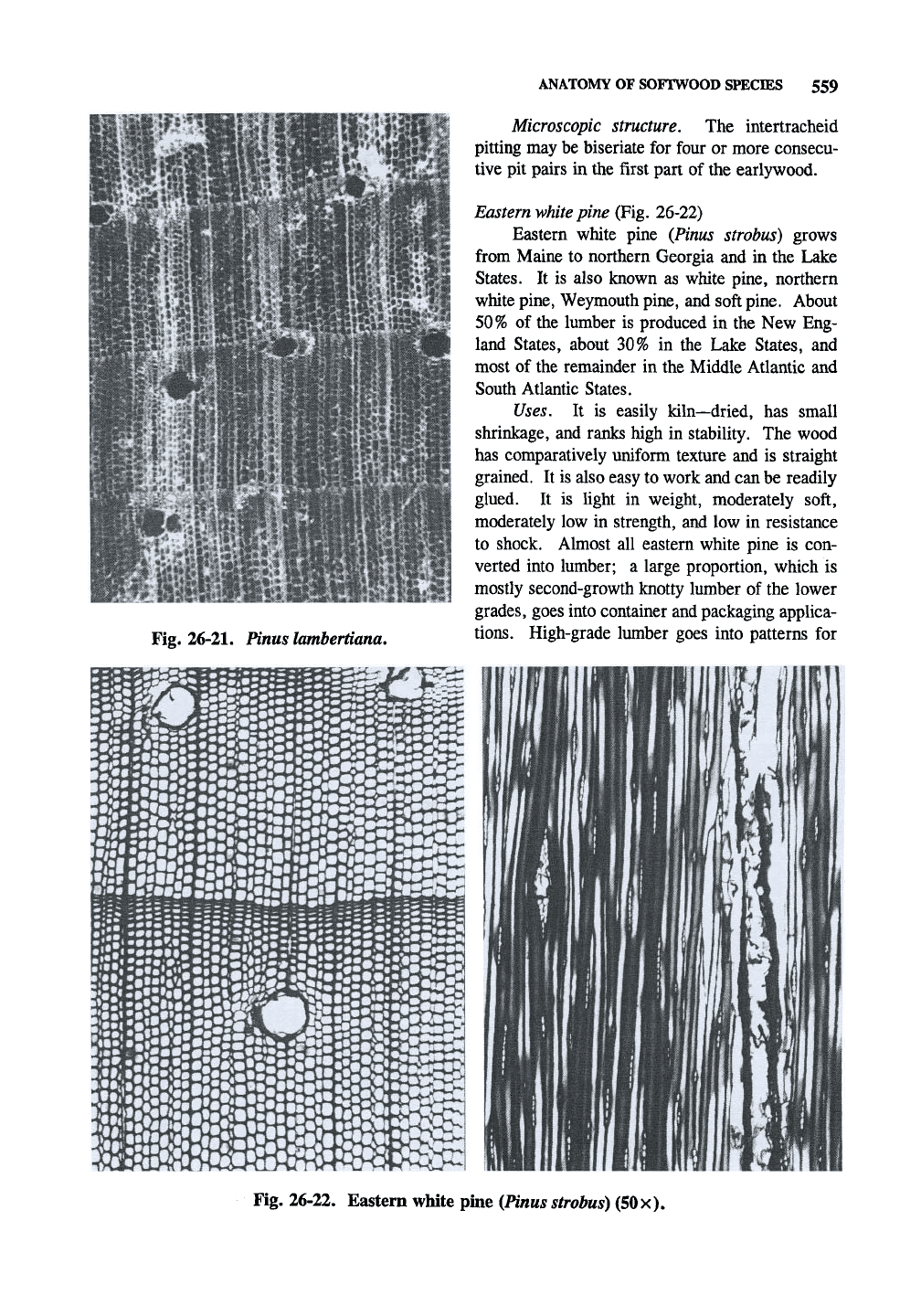
Fig.
26-21.
Pinus lambertiana.
ANATOMY OF SOFTWOOD SPECIES 559
Microscopic structure. The intertracheid
pitting may be biseriate for four or more consecu-
tive pit pairs in the first part of the earlywood.
Eastern
white
pine (Fig. 26-22)
Eastern white pine (Pinus strobus) grows
from Maine to northern Georgia and in the Lake
States. It is also known as white pine, northern
white pine, Weymouth pine, and soft
pine.
About
50%
of the lumber is produced in the New Eng-
land States, about 30% in the Lake States, and
most of the remainder in the Middle Atlantic and
South Atlantic States.
Uses. It is easily kiln—dried, has small
shrinkage, and ranks high in stability. The wood
has comparatively uniform texture and is straight
grained. It is also easy to work and can be readily
glued. It is light in weight, moderately soft,
moderately low in strength, and low in resistance
to shock. Almost all eastern white pine is con-
verted into lumber; a large proportion, which is
mostly second-growth knotty lumber of the lower
grades, goes into container and packaging applica-
tions.
High-grade lumber goes into patterns for
Fig. 26-22. Eastern white pine
(Pinus strobus)
(50x).
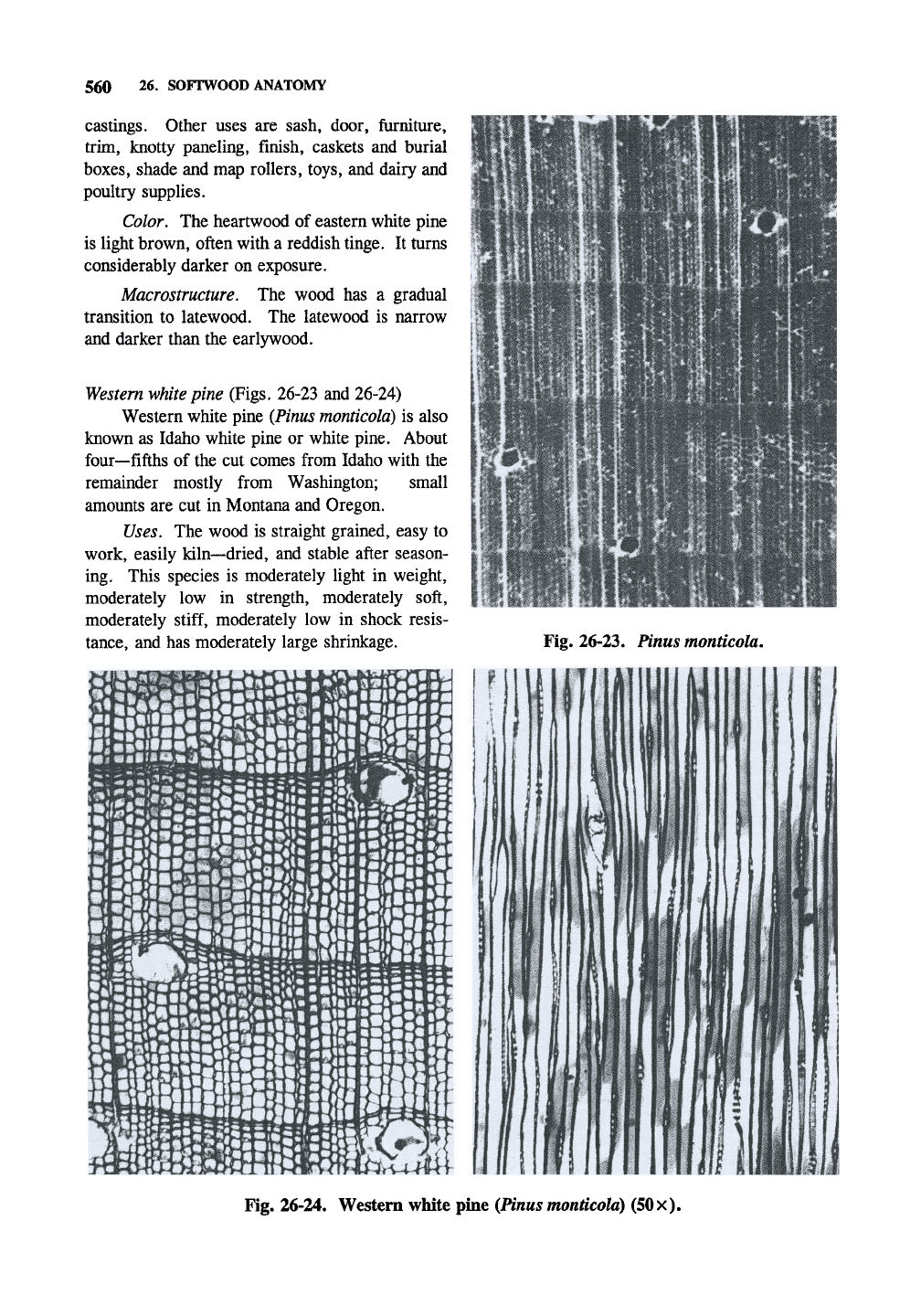
560
26.
SOFTWOOD ANATOMY
castings. Other uses are sash, door, furniture,
trim, knotty paneling, finish, caskets and burial
boxes,
shade and map rollers, toys, and dairy and
poultry supplies.
Color. The heartwood of eastern white pine
is light brown, often with a reddish
tinge.
It turns
considerably darker on exposure.
Macrostructure. The wood has a gradual
transition to latewood. The latewood is narrow
and darker than the earlywood.
Western
white
pine (Figs. 26-23 and 26-24)
Western white pine
{Pinus monticola)
is also
known as Idaho white pine or white pine. About
four—fifths of the cut comes from Idaho with the
remainder mostly from Washington; small
amounts are cut in Montana and Oregon.
Uses. The wood is straight grained, easy to
work, easily kiln—dried, and stable after season-
ing. This species is moderately light in weight,
moderately low in strength, moderately soft,
moderately
stiff,
moderately low in shock resis-
tance, and has moderately large shrinkage.
Fig. 26-23. Pinus monticola.
Fig. 26-24. Western white pine
(Pinus monticola) (50
x).
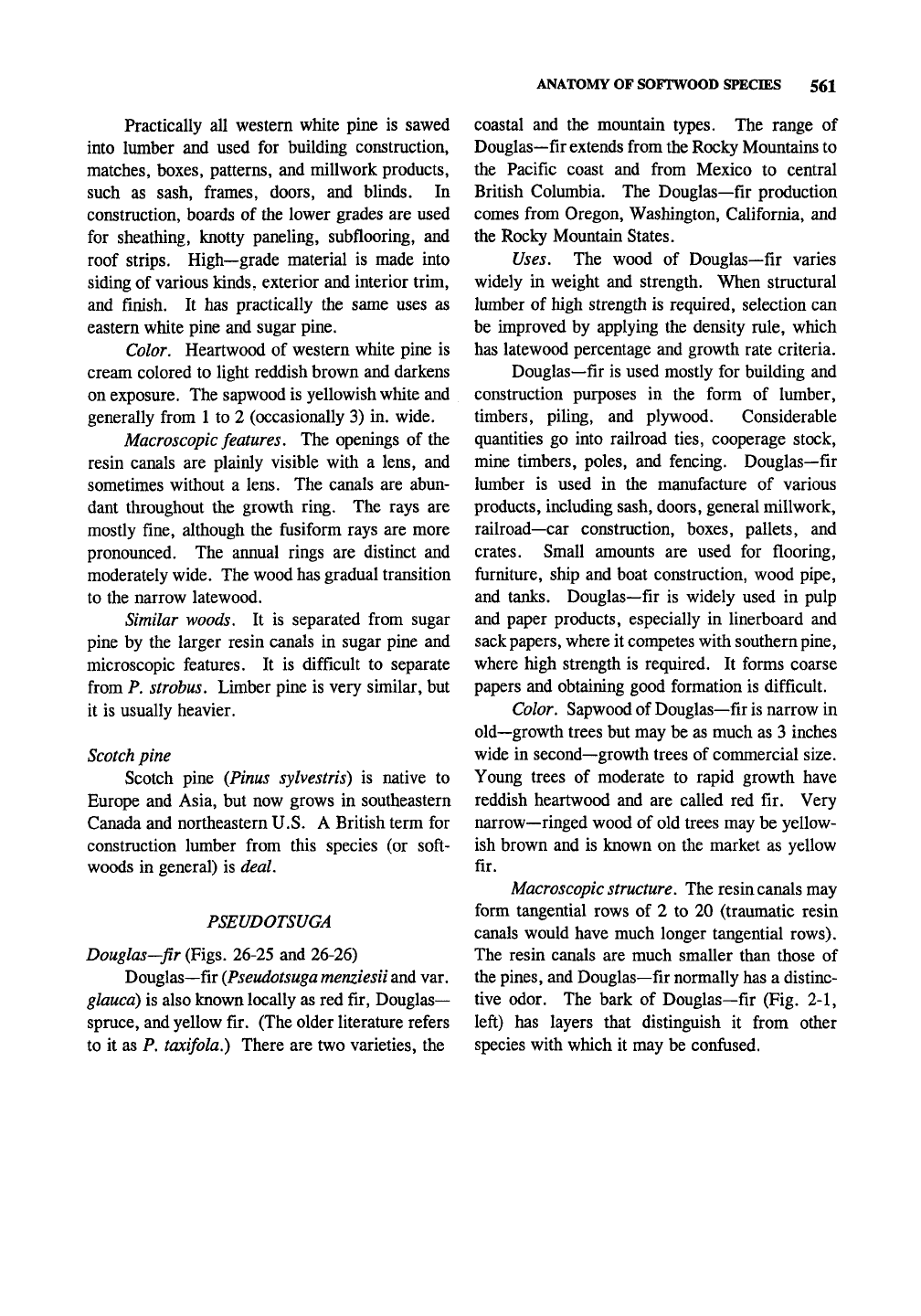
ANATOMY OF SOFTWOOD SPECIES
561
Practically all western white pine is sawed
into lumber and used for building construction,
matches, boxes, patterns, and millwork products,
such as sash, frames, doors, and blinds. In
construction, boards of the lower grades are used
for sheathing, knotty paneling, subflooring, and
roof strips. High—grade material is made into
siding of various kinds, exterior and interior trim,
and finish. It has practically the same uses as
eastern white pine and sugar pine.
Color. Heartwood of western white pine is
cream colored to light reddish brown and darkens
on exposure. The sapwood is yellowish white and
generally from 1 to 2 (occasionally 3) in. wide.
Macroscopic
features. The openings of the
resin canals are plainly visible with a lens, and
sometimes without a lens. The canals are abun-
dant throughout the growth ring. The rays are
mostly fine, although the fusiform rays are more
pronounced. The annual rings are distinct and
moderately wide. The wood has gradual transition
to the narrow latewood.
Similar woods. It is separated from sugar
pine by the larger resin canals in sugar pine and
microscopic features. It is difficult to separate
from P. strobus. Limber pine is very similar, but
it is usually heavier.
Scotch
pine
Scotch pine (Pinus sylvestris) is native to
Europe and Asia, but now grows in southeastern
Canada and northeastern U.S. A British term for
construction lumber from this species (or soft-
woods in general) is deal.
PSEUDOTSUGA
Douglas—fir
(Figs.
26-25 and 26-26)
Douglas—fir
(Pseudotsuga
menziesii and var.
glauca) is also known locally as red fir, Douglas-
spruce, and yellow fir. (The older literature refers
to it as P. taxifola.) There are two varieties, the
coastal and the mountain types. The range of
Douglas—fir extends from the Rocky Mountains to
the Pacific coast and from Mexico to central
British Columbia. The Douglas—fir production
comes from Oregon, Washington, California, and
the Rocky Mountain States.
Uses. The wood of Douglas—fir varies
widely in weight and strength. When structural
lumber of high strength is required, selection can
be improved by applying the density rule, which
has latewood percentage and growth rate criteria.
Douglas—fir is used mostly for building and
construction purposes in the form of lumber,
timbers, piling, and plywood. Considerable
quantities go into railroad ties, cooperage stock,
mine timbers, poles, and fencing. Douglas—fir
lumber is used in the manufacture of various
products, including sash, doors, general millwork,
railroad—car construction, boxes, pallets, and
crates.
Small amounts are used for flooring,
furniture, ship and boat construction, wood pipe,
and tanks. Douglas—fir is widely used in pulp
and paper products, especially in linerboard and
sack
papers,
where it competes with southern pine,
where high strength is required. It forms coarse
papers and obtaining good formation is difficult.
Color. Sapwood of Douglas—fir
is
narrow in
old—growth trees but may be as much as 3 inches
wide in second—growth trees of commercial size.
Young trees of moderate to rapid growth have
reddish heartwood and are called red fir. Very
narrow—ringed wood of old trees may be yellow-
ish brown and is known on the market as yellow
fir.
Macroscopic
structure.
The resin canals may
form tangential rows of 2 to 20 (traumatic resin
canals would have much longer tangential rows).
The resin canals are much smaller than those of
the pines, and Douglas—fir normally has a distinc-
tive odor. The bark of Douglas—fir (Fig. 2-1,
left) has layers that distinguish it from other
species with which it may be confused.
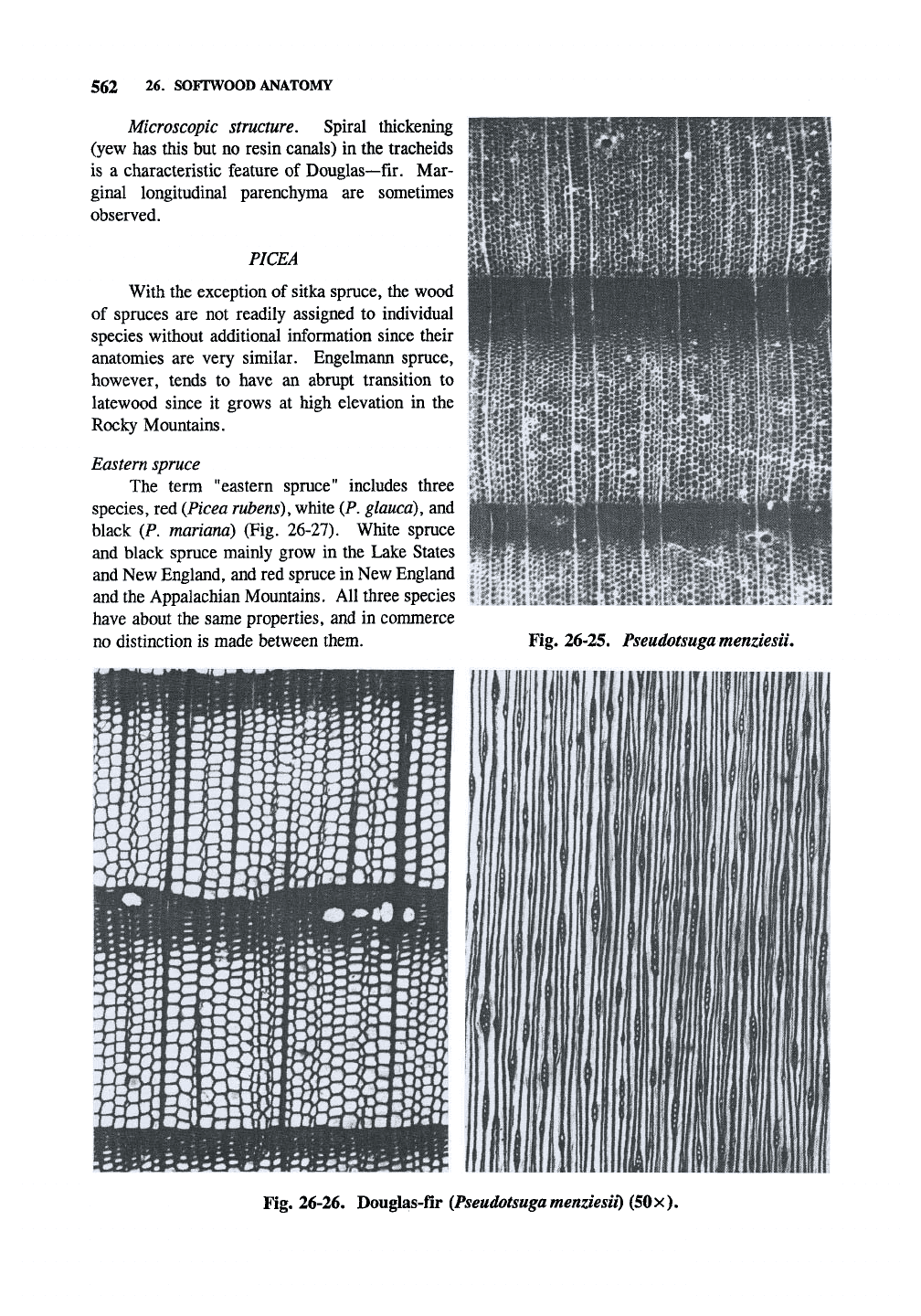
562 26. SOFTWOOD ANATOMY
Microscopic structure. Spiral thickening
(yew has this but no resin canals) in the tracheids
is a characteristic feature of Douglas—fir. Mar-
ginal longitudinal parenchyma are sometimes
observed.
PICEA
With the exception of sitka spruce, the wood
of spruces are not readily assigned to individual
species without additional information since their
anatomies are very similar. Engelmann spruce,
however, tends to have an abrupt transition to
latewood since it grows at high elevation in the
Rocky Mountains.
Eastern spruce
The term "eastern spruce" includes three
species, red (Picea
rubens),
white (P. glauca), and
black (P. mariana) (Fig. 26-27). White spruce
and black spruce mainly grow in the Lake States
and New England, and red spruce in New England
and the Appalachian Mountains. All three species
have about the same properties, and in commerce
no distinction is made between them.
Fig. 26-25. Pseudotsugamenziesii.
Fig. 26-26. Douglas-fir (Pseudotsugamenziesii) (50x).
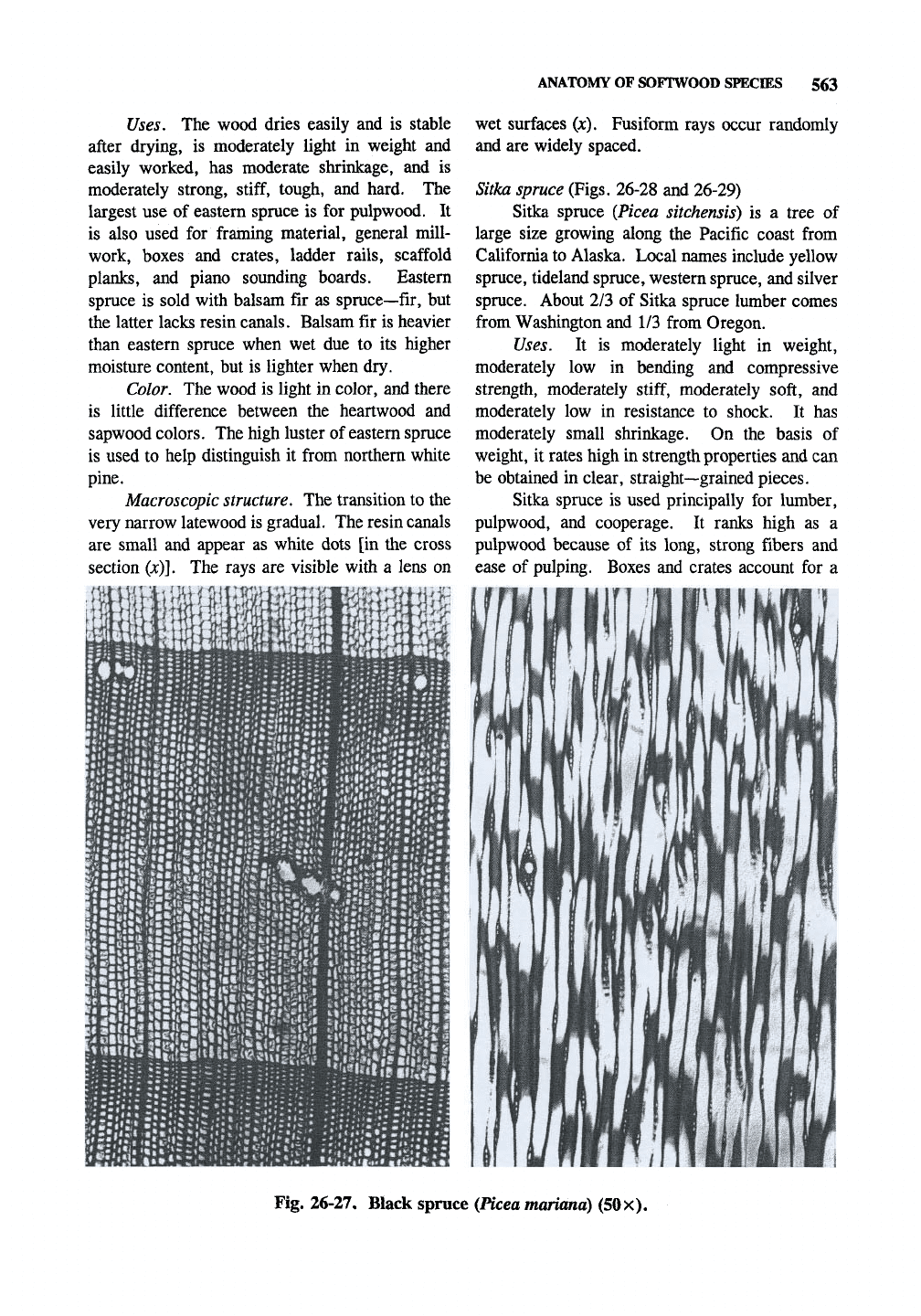
Uses,
The
wood dries easily
and is
stable
after drying,
is
moderately light
in
weight
and
easily worked,
has
moderate shrinkage,
and is
moderately strong,
stiff,
tough,
and
hard.
The
largest
use of
eastern spruce
is for
pulpwood.
It
is also used
for
framing material, general mill-
work, boxes
and
crates, ladder rails, scaffold
planks,
and
piano sounding boards. Eastern
spruce
is
sold with balsam
fir as
spruce—fir,
but
the latter lacks resin canals. Balsam
fir is
heavier
than eastern spruce when
wet due to its
higher
moisture content,
but is
lighter when
dry.
Color.
The
wood
is
light
in
color,
and
there
is little difference between
the
heartwood
and
sapwood colors.
The
high luster
of
eastern spruce
is used
to
help distinguish
it
from northern white
pine.
Macroscopic structure.
The
transition
to the
very narrow latewood
is
gradual.
The
resin canals
are small
and
appear
as
white dots
[in the
cross
section (x)].
The
rays
are
visible with
a
lens
on
ANATOMY
OF
SOFTWOOD SPECIES
563
wet surfaces
(x).
Fusiform rays occur randomly
and
are
widely spaced.
Sitka spruce (Figs. 26-28
and
26-29)
Sitka spruce {Picea sitchensis)
is a
tree
of
large size growing along
the
Pacific coast from
California to Alaska. Local names include yellow
spruce, tideland spruce, western spruce,
and
silver
spruce. About
2/3 of
Sitka spruce lumber comes
from Washington
and 1/3
from Oregon.
Uses.
It is
moderately light
in
weight,
moderately
low in
bending
and
compressive
strength, moderately
stiff,
moderately soft,
and
moderately
low in
resistance
to
shock.
It has
moderately small shrinkage.
On the
basis
of
weight,
it
rates high
in
strength properties
and can
be obtained
in
clear, straight—grained pieces.
Sitka spruce
is
used principally
for
lumber,
pulpwood,
and
cooperage.
It
ranks high
as a
pulpwood because
of its
long, strong fibers
and
ease
of
pulping. Boxes
and
crates account
for a
Fig. 26-27, Black spruce (Picea mariana) (50
x).
